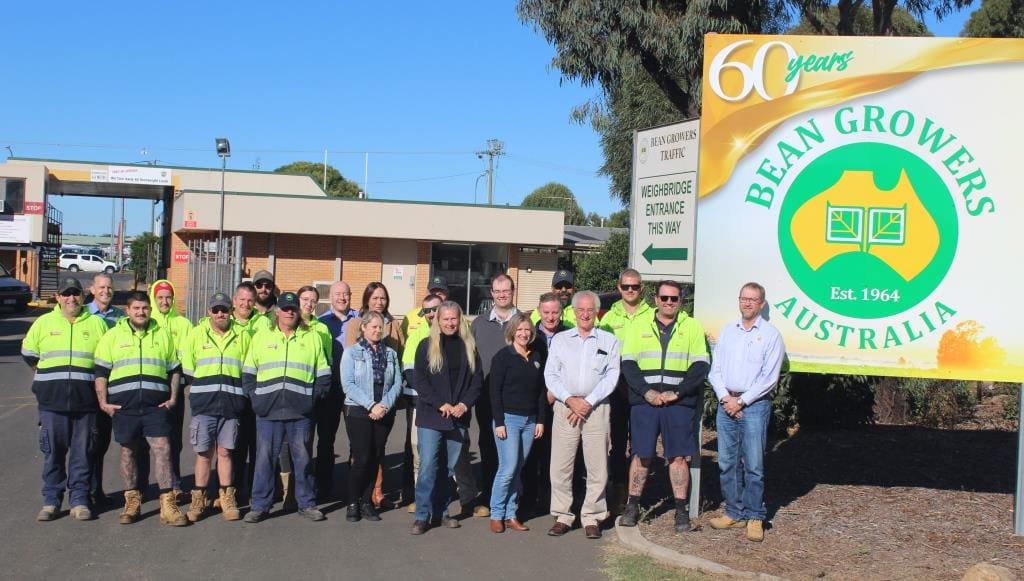
The Bean Growers Australia team on site at Kingaroy.
KINGAROY’S pulse and niche grain processor Bean Growers Australia was born from the desire of local growers to process and sell navy beans produced in the South Burnett.
Now on its 60th anniversary, and with navy beans long gone from the region’s crop rotations, BGA is reflecting on decades of successfully diversifying to suit the needs of growers, buyers, and seasons.
Initially operating as a cooperative, BGA changed to a limited company with shareholders in 2000, and has grown to become one of Australia’s largest pulse processors, supplying ingredients to local and international companies.
BGA today cleans and containerises a range of pulses and grains, with popping corn, mungbeans, soybeans and adzuki beans key crops for the company.
BGA chief executive officer Lloyd Neilsen told Grain Central the company was founded solely to process and sell navy beans after the crop became a staple in the rotation during World War II.
“They used to grow a lot of navy beans in the South Burnett,” Mr Neilsen said.
“The original seed came from the US Government and the US Government asked the Australian Government if Australian farmers could grow some navy beans, because they wanted to be able to supply their soldiers and airmen during the war.”
He said by the 1950s and early 1960s there were hundreds of navy-bean growers in the South Burnett, with the crop sold via a marketing board and trucked to Brisbane for cleaning.
“The local growers wanted to try and form a cooperative and build something in Kingaroy.”
With the help of leading Kingaroy processor, the Peanut Company of Australia, the growers formed a board of directors and formally incorporated the cooperative in 1964.
Mr Neilsen said BGA then acquired a parcel of land, and by the mid-1970s had constructed the majority of the processing facility including silos, an administration block, and its main grading equipment.
“Although they were a group of businessmen and farmers, at the end of the day, they didn’t know anything about grading plants and started from scratch.”
Shift to other crops
Mr Neilsen said navy beans remained BGA’s primary crop for the first few decades, but changing demand and weather conditions necessitated a move into new markets around the turn of the century.
He said the millennium drought, plus the merger of major customers Heinz and Watties, followed by Heinz moving its manufacturing to New Zealand, all took a toll on the navy-bean market.
“BGA had diversified a bit by that stage but… in the early 2000s, we did struggle because we went from a business that was really dependent on navy beans to where we had to diversify.”
The company, pivoted into contracting and selling mungbeans, adzuki beans, popping corn and soybeans, alongside smaller volumes of white chickpeas, linseed, and black-eyed cowpea.
BGA also imports pulses, such as red kidney, black, and pinto beans.
Mr Neilsen said mungbeans and adzuki beans, followed by popping corn, became central to the company’s business after navy beans fell away.
“We’d probably be the largest producer of adzuki beans in Australia.
“We took a bigger bite of the popping corn market; we probably do somewhere between 2000 and 3000 tonnes of popping corn (annually).
“We’ve found a niche by being diversified enough that we can swap and change, depending on where the demand lies in the industry.
“The ability to be able to identify other crops…promote those crops and develop grower skills is something that has stuck to us over the years.”
Mr Neilsen said the wide range of crops also meant BGA had to expand its grower base.
“We’ve got quite a diverse range of growers in a lot of diverse regions.”
He said these included sourcing adzuki beans as far south as Yarrawonga in Victoria, mungbean seeds from the Ord in Western Australia, popping corn and soybeans from the Burdekin in North Qld, and popping corn from Central Qld, alongside mainstay growing regions in southern Qld and northern New South Wales.
Business ventures
Mr Neilsen said the company’s culture of adapting to market and economic conditions has also led to exploring new business opportunities.
He said this included a move into operating rural merchandise stores from the early 1980s.
“In the first instance we had a store in Kingaroy and a store in Murgon, but before we sold that part of our business in 2012, we had about 10 or 12 rural merchandise outlets.”
Mr Neilsen said BGA had recently invested in bringing the locally-produced grains to the retail market via Scarecrow Foods’ microwaveable popcorn product, Popbox.
BGA is a significant shareholder in Scarecrow Foods and supplies all popping corn used to make the product.
“Our diversification into the retail market is something that gives our popping-corn growers a bit of diversity in terms of having a market outlet for some of our popping corn.”
Mr Neilsen said another relatively new element to the firm was achieving BRCGS Global Food Safety certification in late 2023.
He said the system requires a high level of compliance with food safety standards and in Australia “there are only a couple of companies that are certified at that level”.
“One of the things that has given us longevity and security is the fact that we are really focused on the quality.”
Grain Central: Get our free news straight to your inbox – Click here

HAVE YOUR SAY